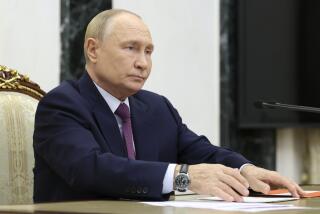A Dangerous Lid to Lift
- Share via
Sept. 11 blew to bits any illusions Americans might have harbored that the danger of devastating attacks on this nation ended with the Cold War. The Pentagon’s Nuclear Posture Review, disclosed this past weekend in The Times, should give pause to any enemy who harbors illusions that post-Cold War retaliation against such attacks would automatically preclude the use of nuclear weapons.
Good. Hard though nuclear counterattack would be to deliver, the free world will be safer if terrorists and rogue states understand that if they kill millions with smallpox or anthrax they may face the United States’ ultimate weapon. That said, there are aspects of the nuclear plan that Bush should publicly disavow--or Congress aggressively challenge: the apparent lowering of the threshold for using nuclear weapons and the blurring of lines between nuclear and conventional weapons.
Nuclear weapons are not just new and improved versions of conventional armaments. They are different in kind from the weapons used on Dresden, Pearl Harbor and Tora Bora. They are so powerful, so awesome, that they have been wielded only twice, in August of 1945.
The Pentagon’s proposed policy suggests new uses for new types of nuclear weapons: “bunker-busters” that can penetrate deep underground to destroy the hide-outs of dictators or storerooms of chemical and biological agents, while releasing relatively low levels of radiation and thereby reducing damage in the region. Developing such weapons would be a dangerous, unacceptable step toward the nuclear brink. Testing such weapons would be dreadful for the world’s health and political balance. The United States has an overwhelming superiority in conventional weapons; in addition it still maintains many thousands of nuclear weapons to deter foes and reassure allies. It has no need for new versions.
The Pentagon review understandably puts North Korea, Iraq, Iran, Syria and Libya on a list of real or potential foes. The list includes Russia and China, despite their improved relations with Washington since the launching of the war on terror. The report suggests that nuclear weapons could be used in the event of “surprising military developments,” a term so vague as to imply a launch-at-will concept rather than the proper policy: as the last resort of a nation faced with annihilation.
Bush administration officials have defended the Pentagon proposals as prudent military planning. It is true that planning is necessary, but merging nuclear and nonnuclear systems as part of the planning could encourage other nations to step up development of their own nuclear weapons.
In 1945, J. Robert Oppenheimer watched the detonation of America’s first atomic weapon, which he helped build, and recalled the lines from the Hindu epic Bhagavad-Gita: “Now I have become Death, destroyer of worlds.” His horror is worth remembering.
More to Read
Sign up for Essential California
The most important California stories and recommendations in your inbox every morning.
You may occasionally receive promotional content from the Los Angeles Times.













